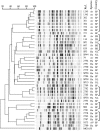Common virulence factors and genetic relationships between O18:K1:H7 Escherichia coli isolates of human and avian origin
- PMID: 17021071
- PMCID: PMC1594794
- DOI: 10.1128/JCM.00548-06
Common virulence factors and genetic relationships between O18:K1:H7 Escherichia coli isolates of human and avian origin
Abstract
Extraintestinal pathogenic (ExPEC) Escherichia coli strains of serotype O18:K1:H7 are mainly responsible for neonatal meningitis and sepsis in humans and belong to a limited number of closely related clones. The same serotype is also frequently isolated from the extraintestinal lesions of colibacillosis in poultry, but it is not well known to what extent human and avian strains of this particular serotype are related. Twenty-two ExPEC isolates of human origin and 33 isolates of avian origin were compared on the basis of their virulence determinants, lethality for chicks, pulsed-field gel electrophoresis (PFGE) patterns, and classification in the main phylogenetic groups. Both avian and human isolates were lethal for chicks and harbored similar virulence genotypes. A major virulence pattern, identified in 75% of the isolates, was characterized by the presence of F1 variant fimbriae; S fimbriae; IbeA; the aerobactin system; and genomic fragments A9, A12, D1, D7, D10, and D11 and by the absence of P fimbriae, F1C fimbriae, Afa adhesin, and CNF1. All but one of the avian and human isolates also belonged to major phylogenetic group B2. However, various subclonal populations could be distinguished by PFGE in relation to animal species and geographical origin. These results demonstrate that very closely related clones can be recovered from extraintestinal infections in humans and chickens and suggest that avian pathogenic E. coli isolates of serotype O18:K1:H7 are potential human pathogens.
Figures



Similar articles
-
Extraintestinal pathogenic Escherichia coli strains of avian and human origin: link between phylogenetic relationships and common virulence patterns.J Clin Microbiol. 2007 Oct;45(10):3366-76. doi: 10.1128/JCM.00037-07. Epub 2007 Jul 25. J Clin Microbiol. 2007. PMID: 17652485 Free PMC article.
-
Extraintestinal pathogenic Escherichia coli O1:K1:H7/NM from human and avian origin: detection of clonal groups B2 ST95 and D ST59 with different host distribution.BMC Microbiol. 2009 Jul 7;9:132. doi: 10.1186/1471-2180-9-132. BMC Microbiol. 2009. PMID: 19583828 Free PMC article.
-
Pathogenomic comparison of human extraintestinal and avian pathogenic Escherichia coli--search for factors involved in host specificity or zoonotic potential.Microb Pathog. 2010 Sep;49(3):105-15. doi: 10.1016/j.micpath.2010.05.004. Epub 2010 May 12. Microb Pathog. 2010. PMID: 20470878
-
[Avian pathogenic Escherichia coli (APEC)].Berl Munch Tierarztl Wochenschr. 2003 Sep-Oct;116(9-10):381-95. Berl Munch Tierarztl Wochenschr. 2003. PMID: 14526468 Review. German.
-
Avian pathogenic Escherichia coli (APEC).Vet Res. 1999 Mar-Jun;30(2-3):299-316. Vet Res. 1999. PMID: 10367360 Review.
Cited by
-
Adhesive threads of extraintestinal pathogenic Escherichia coli.Gut Pathog. 2009 Dec 10;1(1):22. doi: 10.1186/1757-4749-1-22. Gut Pathog. 2009. PMID: 20003270 Free PMC article.
-
Escherichia coli K1-specific bacteriophage CUS-3 distribution and function in phase-variable capsular polysialic acid O acetylation.J Bacteriol. 2007 Sep;189(17):6447-56. doi: 10.1128/JB.00657-07. Epub 2007 Jun 29. J Bacteriol. 2007. PMID: 17601779 Free PMC article.
-
Comparison of extraintestinal pathogenic Escherichia coli strains from human and avian sources reveals a mixed subset representing potential zoonotic pathogens.Appl Environ Microbiol. 2008 Nov;74(22):7043-50. doi: 10.1128/AEM.01395-08. Epub 2008 Sep 26. Appl Environ Microbiol. 2008. PMID: 18820066 Free PMC article.
-
Virulence profiles, phylogenetic background, and antibiotic resistance of Escherichia coli isolated from turkeys with airsacculitis.ScientificWorldJournal. 2014;2014:289024. doi: 10.1155/2014/289024. Epub 2014 Jul 2. ScientificWorldJournal. 2014. PMID: 25105155 Free PMC article.
-
Chicken Production and Human Clinical Escherichia coli Isolates Differ in Their Carriage of Antimicrobial Resistance and Virulence Factors.Appl Environ Microbiol. 2023 Feb 28;89(2):e0116722. doi: 10.1128/aem.01167-22. Epub 2023 Jan 18. Appl Environ Microbiol. 2023. PMID: 36651726 Free PMC article.
References
-
- Arné, P., D. Marc, A. Brée, C. Schouler, and M. Dho-Moulin. 2000. Increased tracheal colonization in chickens without impairing pathogenic properties of avian pathogenic Escherichia coli MT78 with a fimH deletion. Avian Dis. 44:343-355. - PubMed
-
- Barnes, H. J., J.-P. Vaillancourt, and W. B. Gross. 2003. Colibacillosis, p. 631-652. In H. J. B. Y. M. Saif, J. R. Glisson, A. M. Fadly, L. R. McDougald, and D. E. Swayne (ed.), Diseases of poultry, 11th ed. Iowa State University Press, Ames.
-
- Bingen, E., B. Picard, N. Brahimi, S. Mathy, P. Desjardins, J. Elion, and E. Denamur. 1998. Phylogenetic analysis of Escherichia coli strains causing neonatal meningitis suggests horizontal gene transfer from a predominant pool of highly virulent B2 group strains. J. Infect. Dis. 177:642-650. - PubMed
Publication types
MeSH terms
Substances
LinkOut - more resources
Full Text Sources

